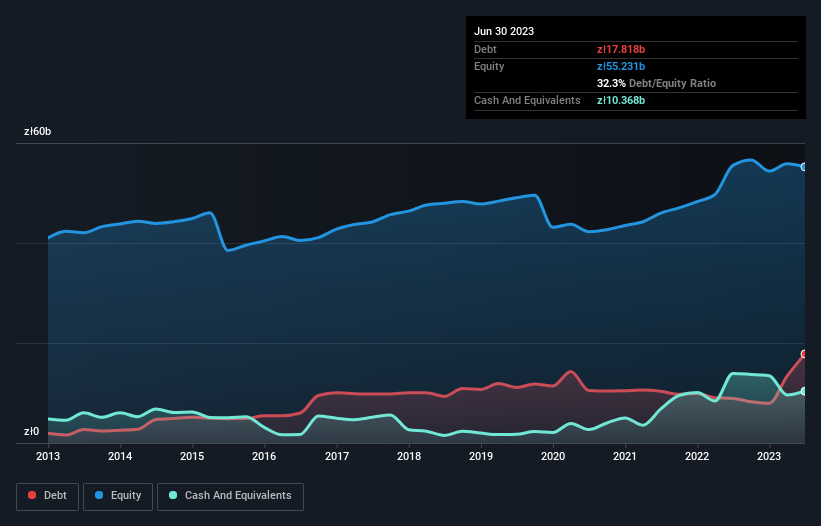
Legendary fund manager Li Lu (who Charlie Munger backed) once said, 'The biggest investment risk is not the volatility of prices, but whether you will suffer a permanent loss of capital.' It's only natural to consider a company's balance sheet when you examine how risky it is, since debt is often involved when a business collapses. We note that PGE Polska Grupa Energetyczna S.A. (WSE:PGE) does have debt on its balance sheet. But the more important question is: how much risk is that debt creating?
Why Does Debt Bring Risk?
Generally speaking, debt only becomes a real problem when a company can't easily pay it off, either by raising capital or with its own cash flow. Part and parcel of capitalism is the process of 'creative destruction' where failed businesses are mercilessly liquidated by their bankers. While that is not too common, we often do see indebted companies permanently diluting shareholders because lenders force them to raise capital at a distressed price. Having said that, the most common situation is where a company manages its debt reasonably well - and to its own advantage. When we examine debt levels, we first consider both cash and debt levels, together.
Check out our latest analysis for PGE Polska Grupa Energetyczna
How Much Debt Does PGE Polska Grupa Energetyczna Carry?
As you can see below, at the end of June 2023, PGE Polska Grupa Energetyczna had zł17.8b of debt, up from zł8.91b a year ago. Click the image for more detail. However, it also had zł10.4b in cash, and so its net debt is zł7.45b.

How Strong Is PGE Polska Grupa Energetyczna's Balance Sheet?
We can see from the most recent balance sheet that PGE Polska Grupa Energetyczna had liabilities of zł31.9b falling due within a year, and liabilities of zł23.9b due beyond that. Offsetting this, it had zł10.4b in cash and zł11.5b in receivables that were due within 12 months. So it has liabilities totalling zł33.9b more than its cash and near-term receivables, combined.
This deficit casts a shadow over the zł15.1b company, like a colossus towering over mere mortals. So we'd watch its balance sheet closely, without a doubt. At the end of the day, PGE Polska Grupa Energetyczna would probably need a major re-capitalization if its creditors were to demand repayment.
We measure a company's debt load relative to its earnings power by looking at its net debt divided by its earnings before interest, tax, depreciation, and amortization (EBITDA) and by calculating how easily its earnings before interest and tax (EBIT) cover its interest expense (interest cover). This way, we consider both the absolute quantum of the debt, as well as the interest rates paid on it.
PGE Polska Grupa Energetyczna's net debt is only 0.94 times its EBITDA. And its EBIT easily covers its interest expense, being 11.1 times the size. So we're pretty relaxed about its super-conservative use of debt. In fact PGE Polska Grupa Energetyczna's saving grace is its low debt levels, because its EBIT has tanked 43% in the last twelve months. When it comes to paying off debt, falling earnings are no more useful than sugary sodas are for your health. The balance sheet is clearly the area to focus on when you are analysing debt. But it is future earnings, more than anything, that will determine PGE Polska Grupa Energetyczna's ability to maintain a healthy balance sheet going forward. So if you want to see what the professionals think, you might find this free report on analyst profit forecasts to be interesting.
Finally, a company can only pay off debt with cold hard cash, not accounting profits. So we clearly need to look at whether that EBIT is leading to corresponding free cash flow. Looking at the most recent three years, PGE Polska Grupa Energetyczna recorded free cash flow of 46% of its EBIT, which is weaker than we'd expect. That's not great, when it comes to paying down debt.
Our View
To be frank both PGE Polska Grupa Energetyczna's EBIT growth rate and its track record of staying on top of its total liabilities make us rather uncomfortable with its debt levels. But on the bright side, its interest cover is a good sign, and makes us more optimistic. It's also worth noting that PGE Polska Grupa Energetyczna is in the Electric Utilities industry, which is often considered to be quite defensive. We're quite clear that we consider PGE Polska Grupa Energetyczna to be really rather risky, as a result of its balance sheet health. For this reason we're pretty cautious about the stock, and we think shareholders should keep a close eye on its liquidity. There's no doubt that we learn most about debt from the balance sheet. But ultimately, every company can contain risks that exist outside of the balance sheet. Be aware that PGE Polska Grupa Energetyczna is showing 1 warning sign in our investment analysis , you should know about...
Of course, if you're the type of investor who prefers buying stocks without the burden of debt, then don't hesitate to discover our exclusive list of net cash growth stocks, today.
New: Manage All Your Stock Portfolios in One Place
We've created the ultimate portfolio companion for stock investors, and it's free.
• Connect an unlimited number of Portfolios and see your total in one currency
• Be alerted to new Warning Signs or Risks via email or mobile
• Track the Fair Value of your stocks
Have feedback on this article? Concerned about the content? Get in touch with us directly. Alternatively, email editorial-team (at) simplywallst.com.
This article by Simply Wall St is general in nature. We provide commentary based on historical data and analyst forecasts only using an unbiased methodology and our articles are not intended to be financial advice. It does not constitute a recommendation to buy or sell any stock, and does not take account of your objectives, or your financial situation. We aim to bring you long-term focused analysis driven by fundamental data. Note that our analysis may not factor in the latest price-sensitive company announcements or qualitative material. Simply Wall St has no position in any stocks mentioned.
About WSE:PGE
PGE Polska Grupa Energetyczna
Engages in the production and distribution of electricity and heat in Poland.
Reasonable growth potential with adequate balance sheet.
Similar Companies
Market Insights
Community Narratives



